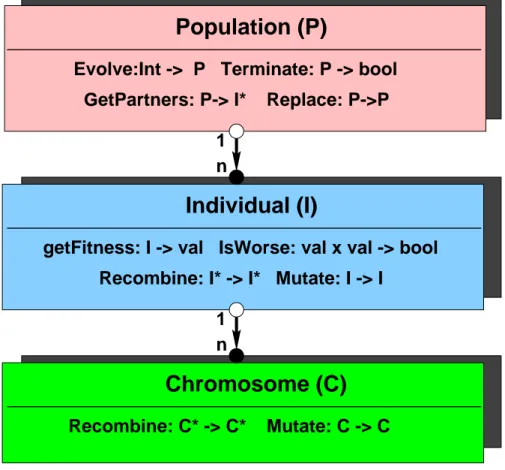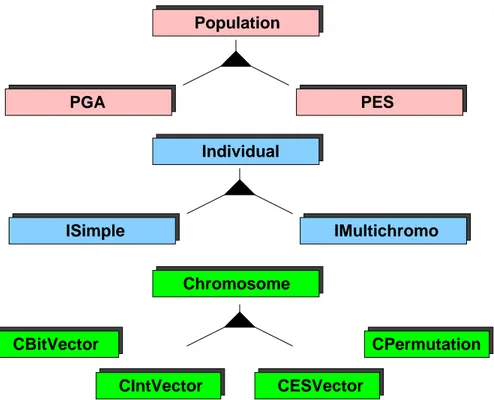TEA - A C++ Library for the Design of Evolutionary Algorithms
Michael Emmerich Rafael Hosenberg
University of Dortmund Dept. Computer Science Systems Analysis Group 44227 Dortmund, Germany
f
emmerich,hosenberg
g@ls11.cs.uni-dortmund.de
Abstract A library for the design of standard and non-standard EAs in C++ is described. The simple object-oriented design of the TEA library allows the fast conguration of new non-standard evolutionary algorithms.
In TEA representation independent algorithms can be combined with non-standard genotypes. Complex genotypes can be build from exist- ing simple genotypes. Furthermore, non-panmictic parallel population structures like neighbourhood and multipopulation EAs are supported.
This paper introduces the main concepts of the TEA library. Examples illustrate how to build standard algorithms and how to design new kinds of algorithms and representations with TEA.
1 Introduction
Evolutionary Algorithms (EAs) utilize paradigms of biological evolution, like recombination, mutation and selection mainly for the solution of global op- timization tasks. As a exible and robust search technique, they have been successfully applied to various real world problems [1].
Some main classes of EAs are evolution strategies (ESs) [7], genetic al- gorithms (GAs) [1] and evolutionary programming (EP) [1]. Today, EAs dier mainly in their search operators, the representation of the search space and the type of optimization problem they are designed for, their population model and their generational transition mechanisms. For a broad overview of current EA concepts the reader is referred to [2] and [1].
The TEA C++ library can be used to build completly new EAs or to modify and/or apply the existing (standard) EAs.
The following targets have been adressed in the design of TEA:
Representation-independent algorithm design
Support of non-standard representations with mixed chromosome types
Possible interactive exchange of search operators (without re-compila- tion)
Pre-dened standard EAs and representations
Representation-independent algorithms require only minimal information about the individuals, which is typically their tness value and their feasibility.
Implementing algorithms this way, allows the user to apply the same algorithm with dierent individual types.
With the support of non-standard representations the conguration of complex genotypes is possible. For example in a complex genotype real vec- tors, bitstrings and integer arrays may be combined. TEA allows to inherit specic operators working on the dierent parts of the genotype. This allows the user a fast development of algorithms.
Search Operators like mutation, initialisation and recombination are de- ned as class-objects in TEA that communicate with the data objects (popu- lations, individuals and chromosomes) they modify. Search Operators can be exchanged during running time and their parameters can easily be modied.
This gives the user the opportunity to implement complex hybrid algorithms.
Moreover, user interactions during the running time of the algorithm are pos- sible.
Often the intention of the user is just to apply a standard EA for a given problem or a slightly modied EA. Therefore, TEA includes pre-dened con- gurations of the most common EAs like GAs and ESs. They can easily be applied for a given optimization task and as a template for new EA congu- rations.
TEA is an abbreviation that means 'Toolbox for Evolutionary Algorithms'.
The term Toolbox has been chosen to point out that the TEA package contains some more programs than the C++ library, like tools to build a simple GUI.
Nevertheless, we will focus in this paper on the features of the C++ library.
In the following the architecture of the TEA library will be explained.
An example will be given, that demonstrates how to congure an evolution- ary algorithm. Lateron we discuss some technical details, like the directory structure and the installation process. The paper continues with an overview of existing components, i.e. evolutionary algorithms and representations in TEA. We conclude the paper with a brief summary of features and discussion of limitations of the library.
2 Components and Structure of the TEA Li- brary
The TEA library works with three main aggregation levels - the chromo-
some, the individual and the population - as it is depicted in Figure 1. All
these objects have their specic operators, which interface is dened in the virtual abstract classes teaChromosome , teaIndividual and teaPopulation . Genotypes in TEA are build of one or more chromosomes. Typically chro- mosomes are sequences of one data-type, like real vectors or bitstrings. For each chromosome ( C ) the following operators are specied:
mutate : Mutates the given chromosome
recombine : Recombine a set of new chromosomes from a given set of chromosomes
init : Initialise the chromosome with a start value
An individual contains all chromosomes of the genotype and may con- tain further (phenotypic) information, that is needed to calculate the tness function. Fitness and constraint evaluations and the management of a set of chromosomes are typical methods of these objects. For each Individual ( I ) these operators are specied:
mutate : Mutate the chromosomes of the given individual
recombine : Recombine a set of new individuals from given set of indi- viduals
getFitness : Get the individuals tness object
checkConstraints : Return the severity of constraints violations A population comprises one or more sets of individuals. Simple popu- lations contain only two sets - the parent population and (temporarily) an ospring population. The operators of the population control the genera- tional transitions for these sets of individuals. For each Population ( P ) these operators are specied:
evolve : Evolve the given Population for a specied number of genera- tions
getPartners : Choose mating partners for recombination from the pop- ulation
recombine : Generate an ospring population by drawing individuals from parent generation and recombine them
mutate : Mutate all or some selected individuals from the ospring population
replace : Select individuals of parental and ospring population to gen- erate a new parent population
terminate : Checks termination criterion
getFitness: I -> val IsWorse: val x val -> bool n
1 n
Recombine: I* -> I* Mutate: I -> I
Individual (I)
Recombine: C* -> C* Mutate: C -> C GetPartners: P-> I* Replace: P->P Evolve:Int -> P Terminate: P -> bool
Population (P)
Chromosome (C)
1
Figure 1: The aggregation scheme of the TEA library and basic operators for the objects chromosome, individual and population
There are many standard population models, individuals and chromosomes that have already been implemented in the TEA library. They all inherit the basic interface of teaPopulation , teaIndiviual or teaChromosome . Figure 2 gives a schematic overview of these objects and their inheritance scheme.
We give a more detailed description of these objects in section 4.
2.1 Example for the Conguration of an EA
It is quite easy to congure an EA from existing TEA components. The following source code is an exerpt from the source code of teaPGAExample .
/* C H R O M O S O M E */
teaCBitVector* cbit = new teaCBitVector();
cbit->resize(10); /* Set Dimension of BitVector */
cbit->createOperators(); /* Create Default Operators */
/* Exchange Mutation-Operator */
teaCBitvectorMutate* SimpleMutator=new teaCBitvectorMutate();
delete cbit->getMutate();
cbit->setMutate(SimpleMutator);
/* Initialise the object- and strategy-parameters */
cbit->init();
/* I N D I V I D U A L */
teaISimple* myISimple = new teaISimple;
myISimple->createOperators();
myISimple->init(cbit); /* Set chromosome prototype */
/* Set the Fitness Function */
teaICFCountOnes *fit_fun = new teaICFCountOnes();
delete myISimple->getCalcFitness();
myISimple->setCalcFitness(fit_fun);
/* P O P U L A T I O N */
/* Construct a GA population object*/
teaPGA *myGAPop = new teaPGA;
myGAPop->createOperators();
/* Set the prototype individual and Population Size (30) */
myGAPop->init(30,myISimple);
/* set Crossover Probability */
teaPGAEvolve* myEvolve = (teaPGAEvolve*)myGAPop->getEvolve();
myEvolve->crossoverProbability=0.5;
/* S T A R T E V O L V E */
myGAPop->view(3);
myGAPop->evolve(100);
myGAPop->view(3);
/* ... delete objects ... */
In Figure 3 a graphical visualization of this procedure is given. We will now follow this routine step-by-step to give a rst impression on how EAs are build in TEA.
First, control parameters from the C++ argument vector or a GUI may
be received. As a simple GUI for for parameter handling on X/UNIX systems
we recommend tkjoe which is part of the TEA software package and can be
easily integrated into a C++ procedure.
After control parameters are received, a prototype individual has to be de- signed, which later serves as a template for the individuals in the population.
We begin with the construction of chromosomes for this prototype individ- ual. To each chromosome genetic operators (mutation and recombinations) are assigned. These operators are class-objects themselves and need to be initialized. To simplify this procedure the method createOperators can be used to set default operators. The specication of chromosomes is completed by initialising them with start values.
Then, the completed chromosomes with their operators is inserted into a new individual. After this, the operators of this individual are constructed.
One of these operators is the tness function object. A tness function ob- ject inherits the interface of the class teaICalcFitness , which is specied in
teaOperator.h . This object serves to calculate the tness value of an individ- ual and check the constraints. The tness value is an object with a compari- son function, named teaValue . It may contain an integer ( teaIntValue ) or a double value , or even a vector of numbers. It is very important to choose a tness-function which is compatible with the individual and its chromosomes, e.g. there are tness functions that expect real vectors as chromosomes and others that expect binary strings as chromosomes. These informations should be all contained in their header le. A collection of dierent tness function objects can be found in the directory fitfun .
The completed individual is now passed to a new population. During the initialization of the Population the prototype may be copied several times, in order to build up the rst parent generation. This is done automatically by the
init() method. The next step is to specify the evolutionary operators for the population, like the selection or replacement operators and the termination function.
The completed population can now be evolved step-by-step applying the
evolve operator. As it can be seen in the examples it is possible to access and view all data of the objects during the evolution. Furthermore strategy parameters may be modied and even operators may be exchanged during the evolution loop. This can all be controlled in the main procedure.
Last but not least, the best tness value that occurred in the evolution process is presented and all remaining objects are deleted.
3 Installation and Support
The installation of TEA is simple, if the Gnu-C++ compiler is used (e.g. ver- sion 2.9.5.2, which is downloadable from the location www.gnu.org/software).
The installation process shall be summed up briey in this section.
ISimple PGA
CBitVector
Population
Individual
CIntVector CESVector Chromosome
IMultichromo
CPermutation PES
Figure 2: The inheritance scheme and implemented chromosomes, individuals and populations of the TEA library.
A. System prerequisites
As system prerequisite a C++ compiler (e.g. Gnu-C++) and the tool 'gmake' is required.
B. Installation
The conguration le "Makele.in" must be adapted to the System Environment (e.g. g++ for Sun Solaris and CC for SGI-IRIX Systems).
The current settings are optimized for SUN Solaris 5.6.
Set the TEA DIR environment variable. It should contain a path (dir- name) to the TEA library.
Bourne-Shell : export TEA DIR=dirname C-Shell : setenv TEA DIR dirname
cd $TEA DIR


